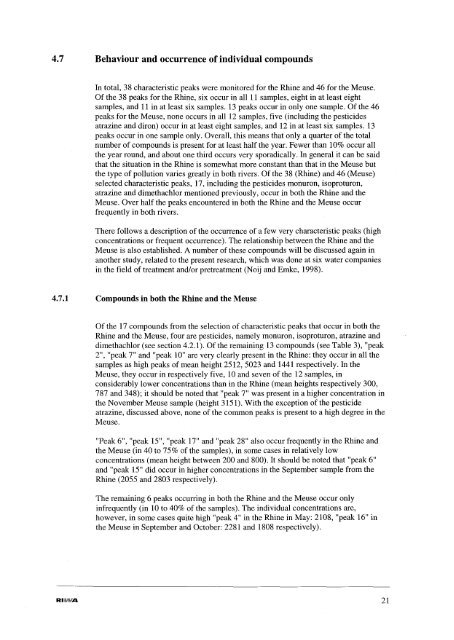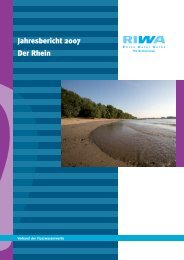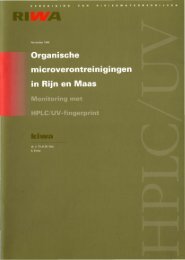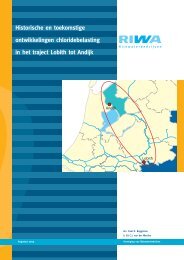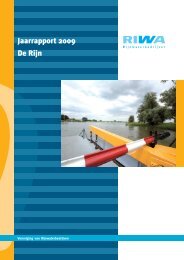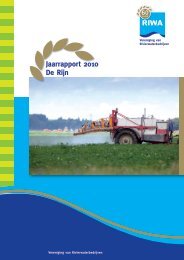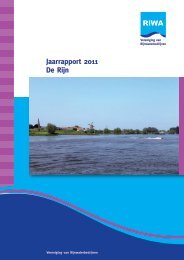Organic micropollutants in Rhine and Meuse a - Riwa
Organic micropollutants in Rhine and Meuse a - Riwa
Organic micropollutants in Rhine and Meuse a - Riwa
Create successful ePaper yourself
Turn your PDF publications into a flip-book with our unique Google optimized e-Paper software.
4.7 Behaviour <strong>and</strong> occurrence of<strong>in</strong>dividual compounds<br />
In total, 38 characteristic peaks were monitored for the Rh<strong>in</strong>e <strong>and</strong> 46 for the <strong>Meuse</strong>.<br />
Of the 38 peaks for the Rh<strong>in</strong>e, six occur <strong>in</strong> all 11 samples, eight <strong>in</strong> at least eight<br />
samples, <strong>and</strong> 11 <strong>in</strong> at least six samples. 13 peaks occur <strong>in</strong> only one sample. Of the 46<br />
peaks for the <strong>Meuse</strong>, none occurs <strong>in</strong> all 12 samples, five (<strong>in</strong>clud<strong>in</strong>g the pesticides<br />
atraz<strong>in</strong>e <strong>and</strong> diron) occur <strong>in</strong> at least eight samples, <strong>and</strong> 12 <strong>in</strong> at least six samples. 13<br />
peaks occur <strong>in</strong> one sample only. Overall, this means that only a quarter of the total<br />
number of compounds is present for at least half the year. Fewer than 10% occur all<br />
the year round, <strong>and</strong> about one third occurs very sporadically. In general it can be said<br />
that the situation <strong>in</strong> the Rh<strong>in</strong>e is somewhat more constant than that <strong>in</strong> the <strong>Meuse</strong> but<br />
the type of pollution varies greatly <strong>in</strong> both rivers. Of the 38 (Rh<strong>in</strong>e) <strong>and</strong> 46 (<strong>Meuse</strong>)<br />
selected characteristic peaks, 17, <strong>in</strong>clud<strong>in</strong>g the pesticides monuron, isoproturon,<br />
atraz<strong>in</strong>e <strong>and</strong> dimethachlor mentioned previously, occur <strong>in</strong> both the Rh<strong>in</strong>e <strong>and</strong> the<br />
<strong>Meuse</strong>. Over half the peaks encountered <strong>in</strong> both the Rh<strong>in</strong>e <strong>and</strong> the <strong>Meuse</strong> occur<br />
frequently <strong>in</strong> both rivers.<br />
There follows a description of the occurrence of a few very characteristic peaks (high<br />
concentrations or frequent occurrence). The relationship between the Rh<strong>in</strong>e <strong>and</strong> the<br />
<strong>Meuse</strong> is also established. A number of these compounds will be discussed aga<strong>in</strong> <strong>in</strong><br />
another study, related to the present research, which was done at six water companies<br />
<strong>in</strong> the field of treatment <strong>and</strong>/or pretreatment (Noij <strong>and</strong> Emke, 1998).<br />
4.7.1 Compounds <strong>in</strong> both the Rh<strong>in</strong>e <strong>and</strong> the <strong>Meuse</strong><br />
Of the 17 compounds from the selection of characteristic peaks that occur <strong>in</strong> both the<br />
Rh<strong>in</strong>e <strong>and</strong> the <strong>Meuse</strong>, four are pesticides, namely monuron, isoproturon, atraz<strong>in</strong>e <strong>and</strong><br />
dimethachlor (see section 4.2.1). Of the rema<strong>in</strong><strong>in</strong>g 13 compounds (see Table 3), "peak<br />
2", "peak 7" <strong>and</strong> "peak 10" are very clearly present <strong>in</strong> the Rh<strong>in</strong>e: they occur <strong>in</strong> all the<br />
samples as high peaks of mean height 2512,5023 <strong>and</strong> 1441 respectively. In the<br />
<strong>Meuse</strong>, they occur <strong>in</strong> respectively five, 10 <strong>and</strong> seven of the 12 samples, <strong>in</strong><br />
considerably lower concentrations than <strong>in</strong> the Rh<strong>in</strong>e (mean heights respectively 300,<br />
787 <strong>and</strong> 348); it should be noted that "peak 7" was present <strong>in</strong> a higher concentration <strong>in</strong><br />
the November <strong>Meuse</strong> sample (height 3151). With the exception of the pesticide<br />
atraz<strong>in</strong>e, discussed above, none of the common peaks is present to a high degree <strong>in</strong> the<br />
<strong>Meuse</strong>.<br />
"Peak 6", "peak 15", "peak 17" <strong>and</strong> "peak 28" also occur frequently <strong>in</strong> the Rh<strong>in</strong>e <strong>and</strong><br />
the <strong>Meuse</strong> (<strong>in</strong> 40 to 75% of the samples), <strong>in</strong> some cases <strong>in</strong> relatively low<br />
concentrations (mean height between 200 <strong>and</strong> 800). It should be noted that "peak 6"<br />
<strong>and</strong> "peak 15" did occur <strong>in</strong> higher concentrations <strong>in</strong> the September sample from the<br />
Rh<strong>in</strong>e (2055 <strong>and</strong> 2803 respectively).<br />
The rema<strong>in</strong><strong>in</strong>g 6 peaks occurr<strong>in</strong>g <strong>in</strong> both the Rh<strong>in</strong>e <strong>and</strong> the <strong>Meuse</strong> occur only<br />
<strong>in</strong>frequently (<strong>in</strong> 10 to 40% of the samples). The <strong>in</strong>dividual concentrations are,<br />
however, <strong>in</strong> some cases quite high "peak 4" <strong>in</strong> the Rh<strong>in</strong>e <strong>in</strong> May: 2108, "peak 16" <strong>in</strong><br />
the <strong>Meuse</strong> <strong>in</strong> September <strong>and</strong> October: 2281 <strong>and</strong> 1808 respectively).<br />
RIIlN'A 21


